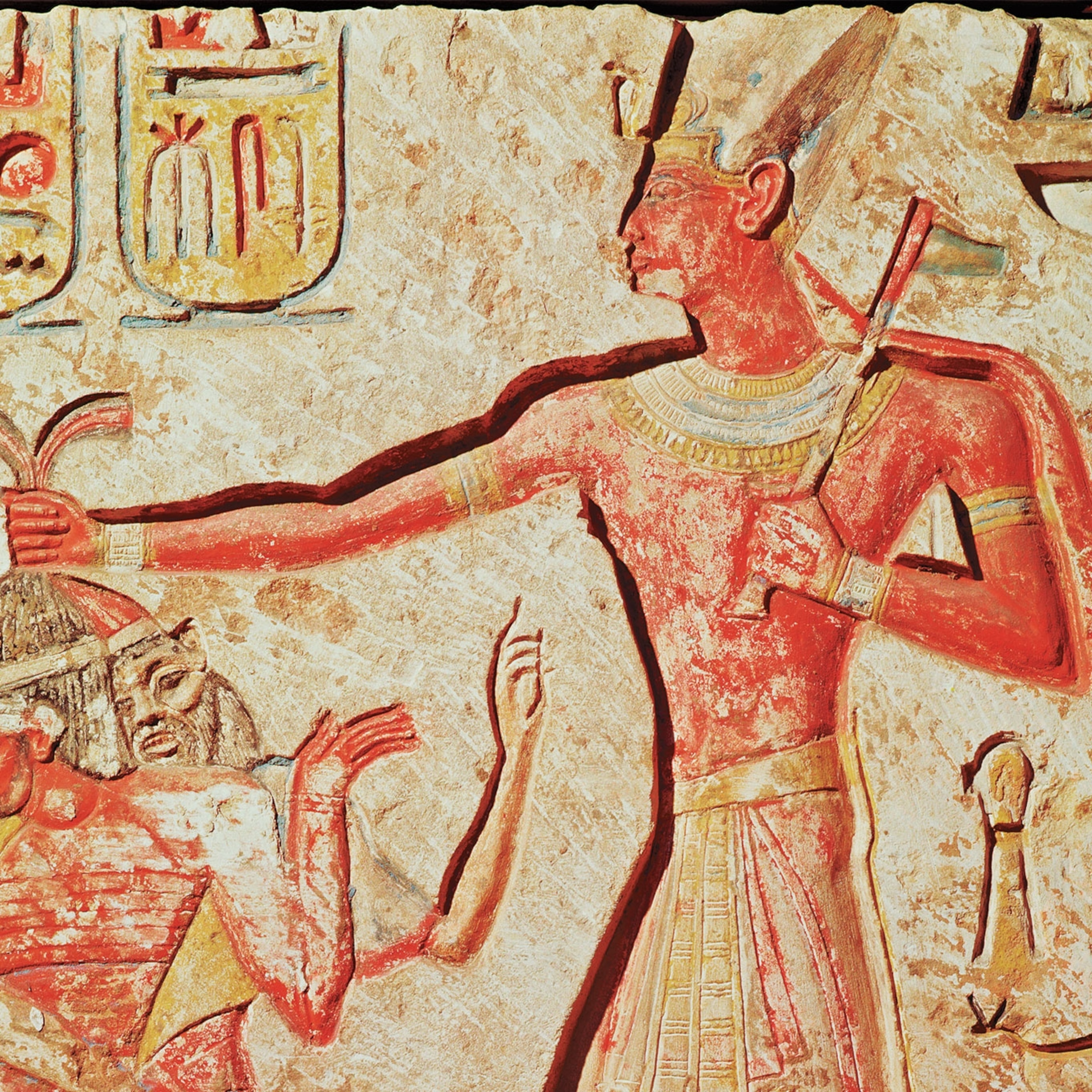These pharaohs' private letters expose how politics worked 3,300 years ago
The Amarna Letters preserve an inside look at Egyptian diplomacy, revealing how power brokers maneuvered, alliances were forged, and pharaohs were flattered.

Sometimes, archaeologists stumble on not just one, or a few, but an entire cache of documents that utterly transforms their understanding of an ancient period, and whose fascinating details bring that distant time into sharp focus. The trove that transformed Egyptology is undoubtedly that of the Amarna Letters, 382 clay tablets considered the oldest documents of diplomacy ever found.

Written in the 14th century B.C., they consist of correspondence between the pharaohs and their rival kings, the Babylonians, Assyrians, Hittites, and Mitanni, as well as letters from puppet kings under Egyptian rule. Beginning in the reign of Amenhotep III (1390-1353 B.C.), Egypt’s great builder king, the archive also tracks the reign of his son, Akhenaten (1353-1336 B.C.), whose religious revolution convulsed ancient Egypt for a generation. The letters open a window into 18th-dynasty Egypt and give a detailed snapshot of the eastern Mediterranean and Middle East in the Late Bronze Age, just as Egypt was consolidating its greatness and the new power of Assyria was beginning to flourish.
Revealing the writers’ flattery, arrogance, jealousy, and groveling, the letters also provide an insight into the developing complexity of international diplomacy. The growth of large empires jostling for supremacy had created the need for a system of rules, and the Amarna communiqués give historians unparalleled insights into how these early rules worked.

City of the sun
Around 1348 B.C., Pharaoh Akhenaten moved his court to an isolated spot farther north, roughly equidistant between Thebes (his former capital) and Memphis. The transfer was part of the pharaoh’s radical program to exalt Aten, the solar disk, as the almost exclusive divinity of Egypt.
Akhenaten’s new capital, on the east bank of the Nile, was called Akhetaten, meaning “horizon of Aten,” possibly because of nearby hills that frame the rising sun. The modern name of the place, Tell el Amarna, is used interchangeably with the site of Akhetaten, and it has given its name to the extraordinary culture that briefly flourished when the upheaval of the pharaoh’s Aten cult paralleled a radical change in art, known as Amarna style.

Akhenaten’s reign, however, was not just centered on religious and artistic upheaval. He had inherited a kingdom of huge power and regional prestige from his father, Amenhotep III, and continued pursuing Egyptian interests, particularly in mineral-rich Nubia to the south. Until his death in 1336 B.C., Egypt’s capital was a bustling city filled with palaces and temples, homes, barracks, and administrative buildings. The latter contained the ongoing archive of diplomatic letters, begun under Amenhotep III and Queen Tiye. (King Tut's grandparents were Egypt's royal power couple.)
The ancient city was identified at Amarna in the late 1700s, when Akhetaten’s boundary stone was found there. The letters came to light in the 1880s after a series of chance finds. As news of their existence spread, the site suddenly acquired huge archaeological importance. The curator of the British Museum, Wallis Budge, managed to obtain a batch of 82 pieces. A significant number of tablets also found their way via the antiquities market to the Egyptian Museum in Cairo and the Staatliche Museum in Berlin.

Led by British Egyptologist William Flinders Petrie in the 1890s, the first significant excavation at Amarna soon uncovered more tablets from the time of Akhenaten. During his first campaign, Petrie excavated a building with the name “Bureau of Correspondence of Pharaoh” stamped on its bricks.
A meticulous archaeologist, Petrie also had an instinct for publicity. He knew the Amarna Letters would help attract patrons to fund the dig. His examinations of the documentary riches of the letters and the archaeological remains of the ancient capital hugely boosted knowledge of this dynasty and the New Kingdom.
Not all the letters were found at once. When the Norwegian linguist Jørgen Alexander Knudtzon ordered them chronologically within geographic groupings in the early 1900s, there were 358. The remaining 24 were discovered in the course of the 20th century and incorporated into Knudtzon’s system of numbering, still used by scholars today. (Here's what the Armana Letters reveal about ancient pirates.)
The letters are not written in ancient Egyptian, but in Akkadian, a language spoken widely in ancient Mesopotamia. In the second millennium B.C., Akkadian became a lingua franca across the whole region, similar to the role English plays in international relations today. It is written in the wedge-shaped writing system, cuneiform. Most of the tablets found to date are letters received by the Egyptians. Only a few copies were retained of letters written by the pharaohs.
Letters from puppets
Scholars have divided the Amarna Letters into two principal groups. One is letters to the pharaoh from the leaders of states controlled by Egypt, and the other is letters to the pharaoh written by his equals (or as he would have seen them, his near equals), the rulers of the other great, independent regional powers.
The former category, dispatches from puppet kings, are from Canaan, located in modern-day Israel and Lebanon. Egypt had seized Canaan as an imperial trophy a century before under Thutmose III. The new acquisition brought Egypt problems along with prestige: Its rulers were harried by a people called the Habiru, identified by some historians as the Hebrews, although their identity is still hotly debated. The temptation for puppet rulers to make deals with local Habiru was, apparently, very great. An Amarna dispatch from the ruler of Tyre to Akhenaten (Letter 148) complains that the Habiru have laid waste to the region, but that another local ruler, that of Hazor (modern-day northern Israel) supposedly loyal to Egypt, “has aligned himself with the Habiru . . . [and] has turned over the king’s land to the Habiru.” (A Canaanite palace was abandoned 3,700 years ago. Archaeologists finally know why.)

These letters are often expressed in language of extreme abasement. The puppet ruler of Gezer, in present-day Israel, wrote: “To the king, my lord, my god, my Sun, the Sun of heaven: Message of Yapahu, your servant, the dirt at your feet. I fall at the feet of the king, my lord, my god, my Sun, seven times and seven times.”
Betrothals and brides
In contrast, the letters written by the pharaoh’s equals, rulers of the great regional powers, are careful how and when they demonstrate that they are on more equal footing. Scholars sometimes refer to the main regional powers of this time as the “Great Powers Club,” which at this time consisted of Egypt, Babylonia, Assyria, Mitanni (centered in modern southeastern Turkey), and “Hatti,” the Hittite empire. Another member of the club was Alashiya, the island of Cyprus. While geographically small, the island nation was economically powerful thanks to its copper reserves. (The Hittites' swift war chariots kept Egypt on edge.)
A few of the letters date back to the reign of Amenhotep III and his great royal wife, Tiye, who was also Akhenaten’s mother. After Amenhotep’s death, his widow remained powerful when her son took the throne. Akhenaten took his father’s archives with him to the new capital as a record of diplomatic relations with Egypt’s allies and vassal states.

Some of the Amarna archive concerns the exchanging of royal princesses as wives. A rare example of an Amarna missive actually written by the pharaoh is Letter 5, from Amenhotep III to the Babylonian king Kadasman-Enlil I. In just 30 lines, the letter covers the principal themes of royal communication: effusive well-wishing, the dispatch of costly presents, and the pharaoh’s hopes to receive a Babylonian princess for his harem. (See inside one of Egypt’s biggest royal weddings.)
The pharaoh could expect to receive a wife, but a sign of Egypt’s supremacy was the pharaoh’s consistent refusal to give wives in return. An earlier dispatch (Letter 4) from Kadasman-Enlil I to Amenhotep complains at the injunction that “since earliest times no daughter of the king of Egypt has ever been given in marriage.” The Babylonian king chafes at the edict: “Why are you telling me such things? You are the king. You may do as you wish. If you wanted to give me your daughter in marriage who could say you nay?” His frustration is shared by other kings in the archive, and lays bare the reality of regional power: Egypt could call the shots.
Egypt and its neighbors

Much as it is today, the geopolitical situation in the Middle East was complex and in flux in the 14th century B.C. It was during this period that the Hatti (Hittites) were expanding, while the once powerful kingdom of Mitanni went into decline. The Assyrian Empire, based in Ashur, took advantage of the power vacuum to grow, while the house of Babylon held strong but remained wary of the threat from Assyria.
The Amarna Letters reflect this change. In addition to playing off the interests of the other big regional players, Egypt had to maintain its imperial holdings in the Levant, where cities such as Tyre complained of harassment from the mysterious Habiru people. The pharaoh was also on the alert for signs of betrayal from his puppet rulers.
Royal etiquette
Some of the most revealing letters about kingship and power are those sent from Tushratta, king of Mitanni, whose expanding empire had a southern border with Egypt’s northernmost holdings in Lebanon. Tushratta opens his letters with a codified greeting, set down by the Great Powers to establish the authenticity of the sender. Letter 27 takes the form of an elaborate pattern of well-wishing. As the king of Mitanni is an equal, he refers to the pharaoh as “brother,” and opens with these words:
Say to Naphurreya [Akhenaten], the king of Egypt, my brother, my son-in-law, whom I love and whom loves me: Thus Tushratta, Great King, the king of Mitanni, your father-in-law, who loves you, your brother. For me all goes well. For you may all go well. For Tiye, your mother, may all go well. For Tadu-Heba, my daughter, your wife, for the rest of your wives . . . may all go very, very well.

The daughter Tushratta mentions, Tadu-Heba, had been a lesser wife to Akhenaten’s father, Amenhotep III. After his death, she became a wife to Akhenaten. This alliance was vital to Tushratta, as the Mitanni were constantly harried by the Hittites to their north and needed a strong alliance with Egypt. (Meet the three queens who led Egypt against Hyksos invaders—and won.)
There is an underlying tension in the letter explained by the previous missive, Letter 26, written not to Akhenaten, but to Queen Tiye. Tushratta complains to the pharaoh’s mother that gifts her late husband, Amenhotep III, had promised to Tushratta (detailed in Letter 19), had included two gold statues. On arrival, these were discovered to be not solid gold at all, but “[gold]-plated statues of wood.”

Scholars are unsure as to whether the cheaper statues were an intentional snub to Tushratta, and an indication of Mitanni’s diminished status in the eyes of Egypt. Tushratta was the weaker here, but he had to maintain his prestige. The dispute continues in Letter 28, where Tushratta complains that as his messengers were detained by Akhenaten, so he has detained Egypt’s.
Tushratta was soon to suffer defeat at the hands of his former vassal king, the Assyrian Ashuruballit I. As Mitanni power waned, so Assyria started to wax. Ashuruballit I does not yet call himself a brother in his first letter to Akhenaten (Letter 15), but it is a bold declaration that Assyria had joined the “Club”: He had treasure to bestow—“a splendid chariot, horses, and a date-stone of genuine lapis lazuli”—but expected respect in return.
The sudden rise of Assyria caused indignation in other quarters, especially in Babylon whose king wrote to Akhenaten in Letter 9. After the usual gift-giving and well-wishing, he asks: “Why on their own authority have the Assyrian envoys of my vassal [i.e., Ashuruballit I] come to your country? If you love me, they will conduct no business whatsoever. Send them off to me empty handed.” Such protests, however, were as nothing to the realities of power. Assyria continued to grow, and Akhenaten’s Egypt remained the preeminent power in the region. (These ancient artifacts honor Egypt's powerful queens.)
Even so, in Egypt, Akhenaten’s new cult of Aten would fail. The last letters of the Amarna archive date from the reign of his son and successor, Tutankhamun, under whose rule the Amarna reforms were rolled back, and references to Akhenaten’s name erased.

Akhenaten’s capital was left for the desert to swallow. At some stage in its abandonment, a civil servant must have placed the diplomatic tablets in two small pits under the floor of the administrative building where they remained in their hiding place. There, they were discovered during another age of empire more than 3,000 years later.








